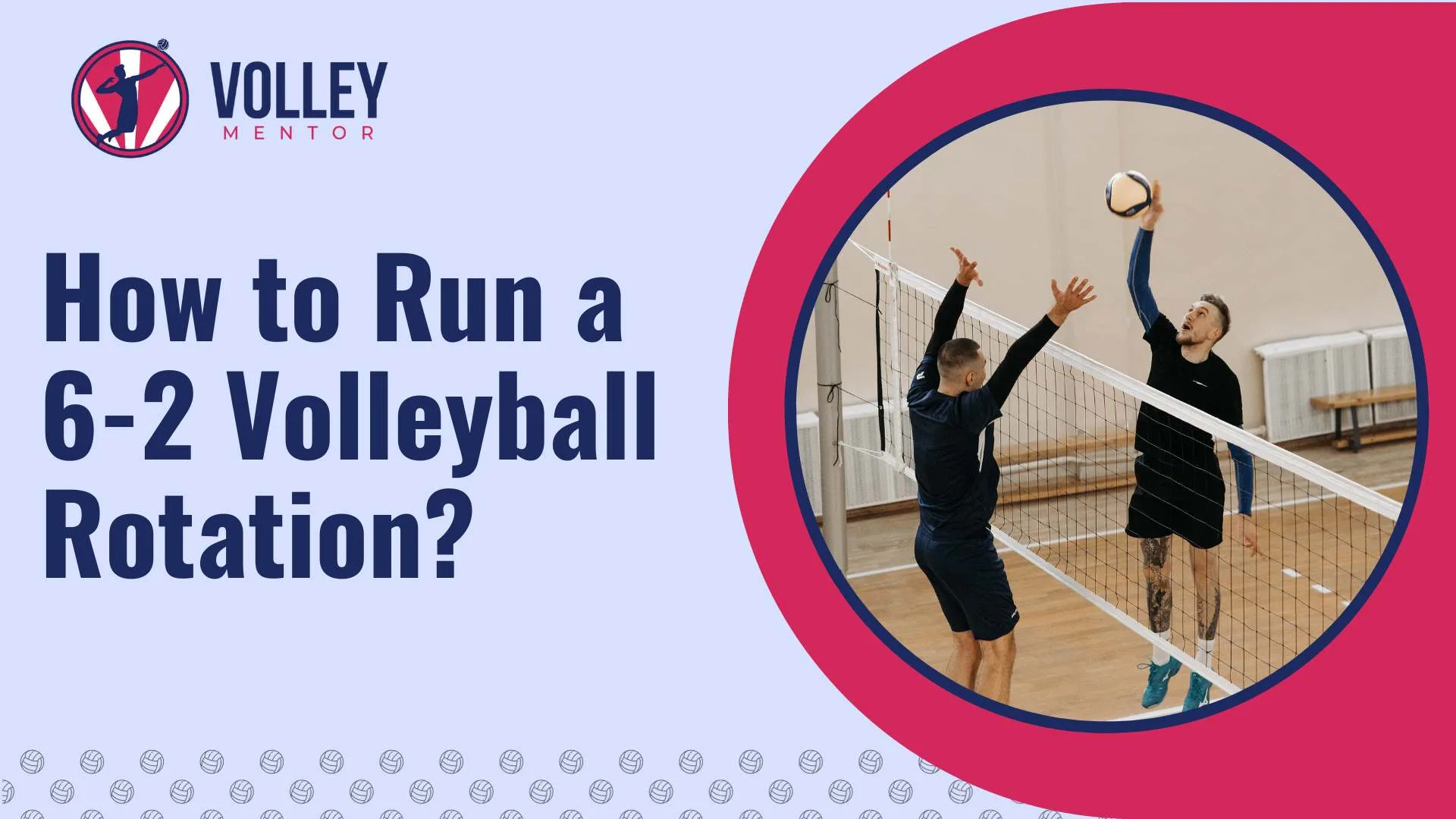

Volleyball is all about the right strategies, the perfect formations, and spot-on precision.
Across the globe, many teams prioritize the 6-2 rotation, making it a top pick for offensive play.

It combines flexibility and power, making it a favorite for many coaches, including me!
Quick Answer: The 6-2 volleyball rotation means having 6 hitters and 2 setters going through six different rotations. The setters only set from the back row, ensuring three attackers in the front at all times.
It allows all six players to be potential hitters, making it ideal for teams aiming to maintain a solid offensive front.
In this guide, I’ll dive deep into the 6-2 rotation, covering everything from serve-receive mechanics to its pros and cons.
And hey, if you’re just starting and need an intro-level volleyball rotations guide, look at my article on the 4-2 rotation.
And if you’re keen on a straightforward setup with one setter running the show, check out my take on the 5-1 rotation.
It’s great for teams looking to maximize consistency and smooth their gameplay.
The 6-2 rotation in volleyball is an intelligent way to play.
When we say ‘6’, it means that all six players on our side can be hitters.
It’s like having six potential superheroes on the team, ready to score points!
Now, the ‘2’ stands for two clever setters.
They take turns, making sure there’s always one of them in the back row.
This players’ formation works great because three strong players line up near the net while one setter sets the ball.
What’s super cool about the 6-2 rotation?
It keeps the opponents guessing.
They never know what we’ll do next, and that’s a game-changer in volleyball.
It’s like having a special move up our sleeve!
Volleyball strategies come in various forms, and the 6-2 formation holds a special place among them.
Here’s a deeper dive into the advantages of this rotation.
I will also explain why it’s a top choice for many seasoned coaches.
With the 6-2 rotation, you always have three hitters at the front, ready and waiting.
This trio acts like the frontline of an army, always prepared for powerful spikes and making those scoring plays.
Having these three players upfront increases your chances of securing points.
The reason is that it keeps the opposition constantly on edge.
If you are lucky to have setters who can both set and hit effectively, the 6-2 rotation lets them showcase this dual talent.
In this setup, they can transition from setting to hitting seamlessly.
It helps make your team’s plays unpredictable and dynamic.
I call it a secret weapon that your opponents can’t predict or judge easily.
Volleyball is often associated with tall players.
But height isn’t everything.
If your team has shorter setters, who can’t do high vertical jumps, the 6-2 rotation can be a tactical move.
This positioning gives them a strategic advantage, allowing them to focus on the setting without the constant threat of direct attacks.
The 6-2 formation isn’t just about the players on the court.
This rotation system is also about those waiting on the sidelines.
With it, coaches get a broader canvas to play with substitutions.
Players can be rotated in and out more frequently, ensuring everyone stays fresh and energized.
One less highlighted yet significant benefit of the 6-2 rotation is how it promotes team fluidity and adaptability.
With multiple hitters and setters in play, players often develop a broader skill set.
They learn to adapt quickly to various game scenarios.
It creates a team environment where players understand multiple roles.
While the 6-2 volleyball rotation has unique strengths, knowing its limitations is equally important to make better-informed decisions.
With every rotation, the setter moving from the back row to the front needs to be swift and flawless in their transition.
Any delay can disrupt the team’s rhythm.
Additionally, if the serve-receive isn’t accurate, the setter might find it challenging to set the ball optimally.
It can lead to a weaker attack or even severe errors.
When you have two leading setters in a team, their coordination is vital.
Each setter might have a slightly different style or preference regarding setting.
If they don’t resolve these differences, they might struggle with timing.
They might also not anticipate the ball’s direction accurately.
So, constant communication and understanding between the two setters is essential in this rotation system.
In the 6-2 rotation, teams often switch players in and out.
This frequent swapping can be tricky.
Teams must follow specific rules when substituting players, which can sometimes get confusing.
It might disrupt the team’s flow or even lead to penalties if not done right.
As a coach, I prioritize organizing practice sessions for my players, ensuring they memorize those crucial substitutions.
Mastering this can genuinely set our team apart on the court!
The 6-2 serve receive rotation is a popular system used by teams, and today, I will demonstrate it for you with the help of easy-to-understand diagrams.
As you are ready to learn the 6-2 rotation system in detail, it’s crucial to remember essential rotation rules.
Always ensure players don’t overlap before the serve.
Plus, player positions should be diagonally opposite to one another.
For instance, if S2 is positioned at the top left, S1 should be at the bottom right.
Throughout my demonstration of the 6-2 system, I’ve ensured these fundamental rules are consistently followed and highlighted.

At times, you might notice some variations, like the middle in the back row becoming the libero or the outside in the back row taking on the role of DS.
This switch-up depends on a team’s defensive strategy.
The front-row setter could double as a right-side hitter, adding an element of surprise to the team’s offense.
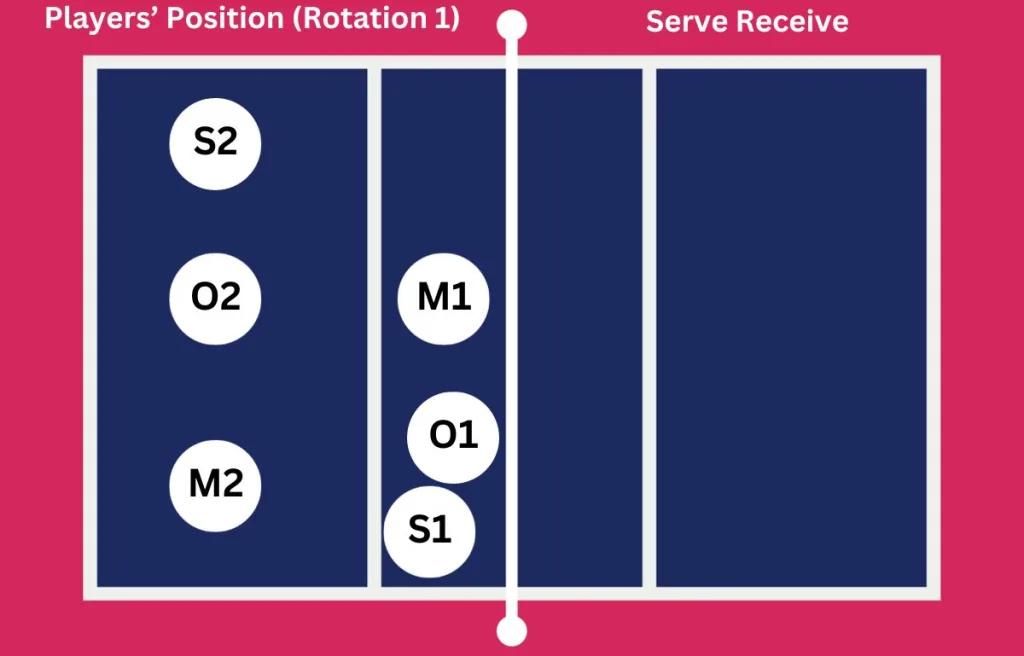
Here’s an overview of the formation that I made for the explanation:
The stack of the players depends on the team’s strengths and strategies.
But no matter how creative you get, always stick to rotation rules.
One golden rule?
The setter should always stay in the middle and be ahead of the outside hitter.
When the opponents serve, players swiftly transition to their offensive stance.
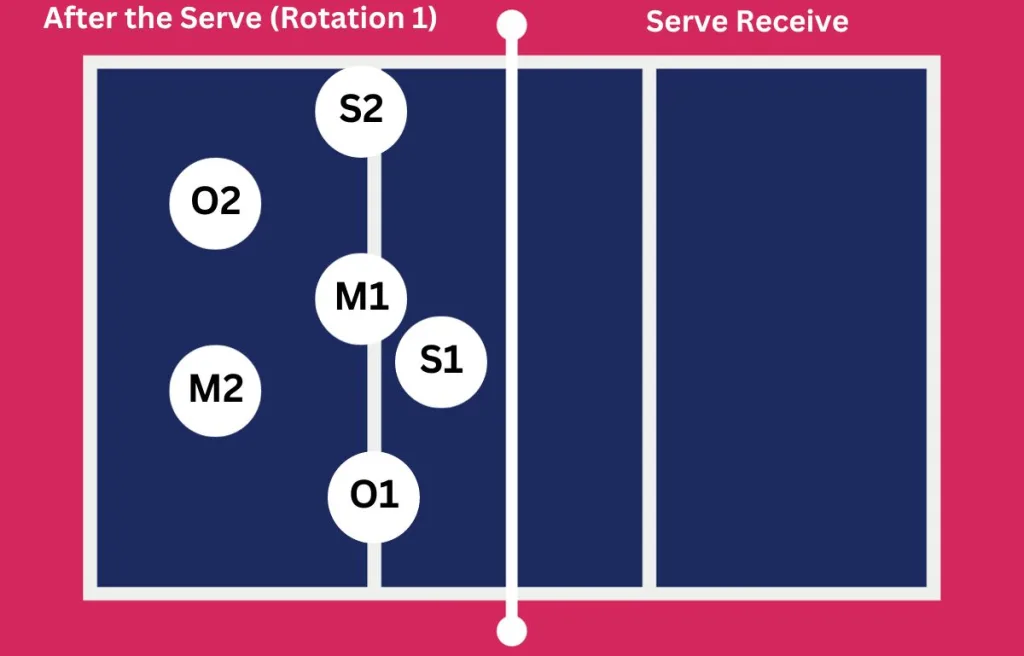
If the receiving team wins the rally, it’s time to celebrate the point win.
Also, they will return to their base position.
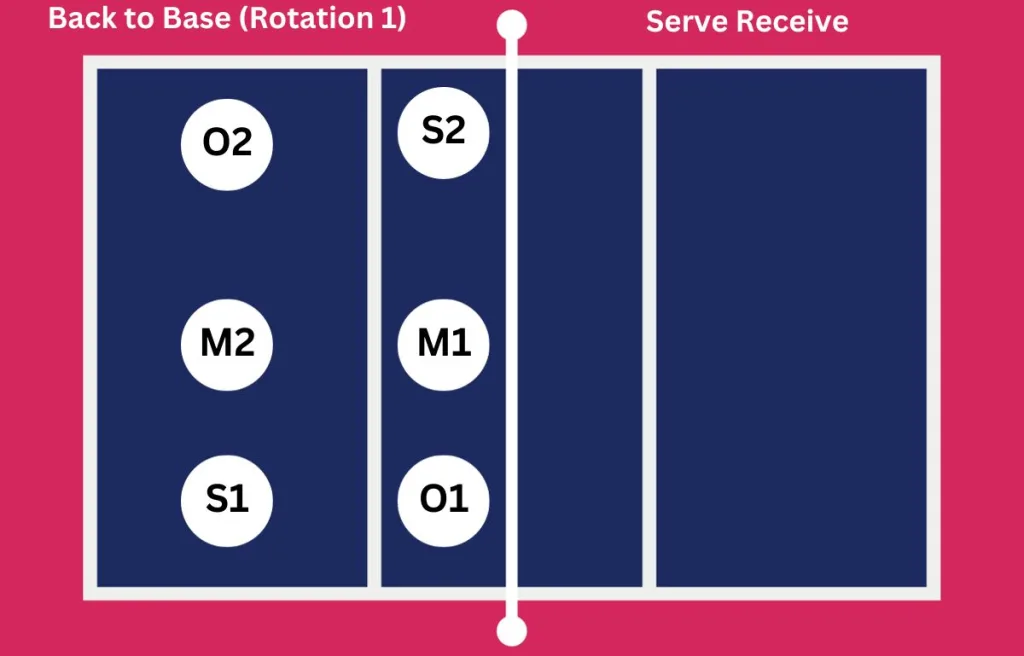
If your team’s next up to serve, you could prep for the next rotation immediately.
After winning the point and before your team serves, players will rotate clockwise to the next position.
So, if you were in position 1, you’d move to position 6.
In the same way, if you were in position 2, you’d move to position 1, and so on.
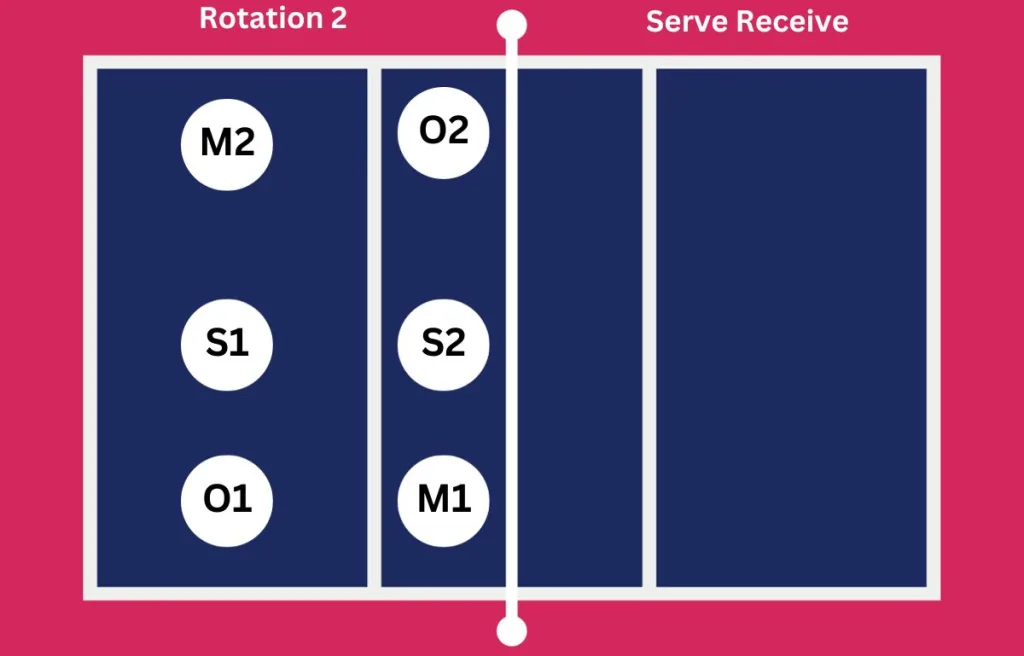
The middle blocker is now closer to the 10-foot line, poised for a quick attack.
Meanwhile, the right-side hitter (S2) stays near Setter 1, ensuring a fluid synergy between them.
I have shown this in the below image.
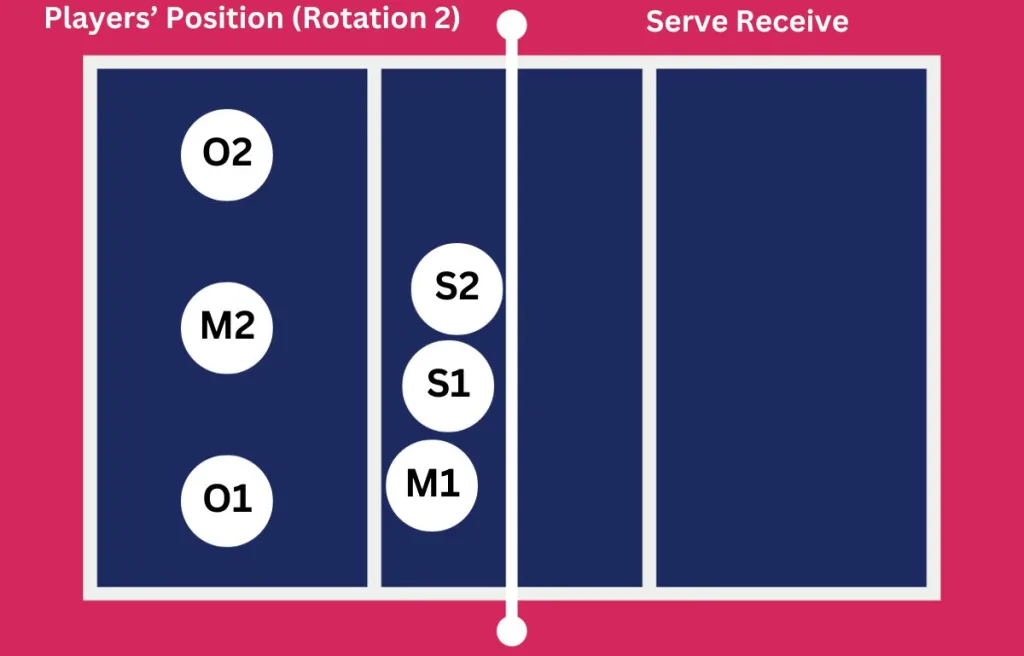
Upon receiving the serve, players come into action.
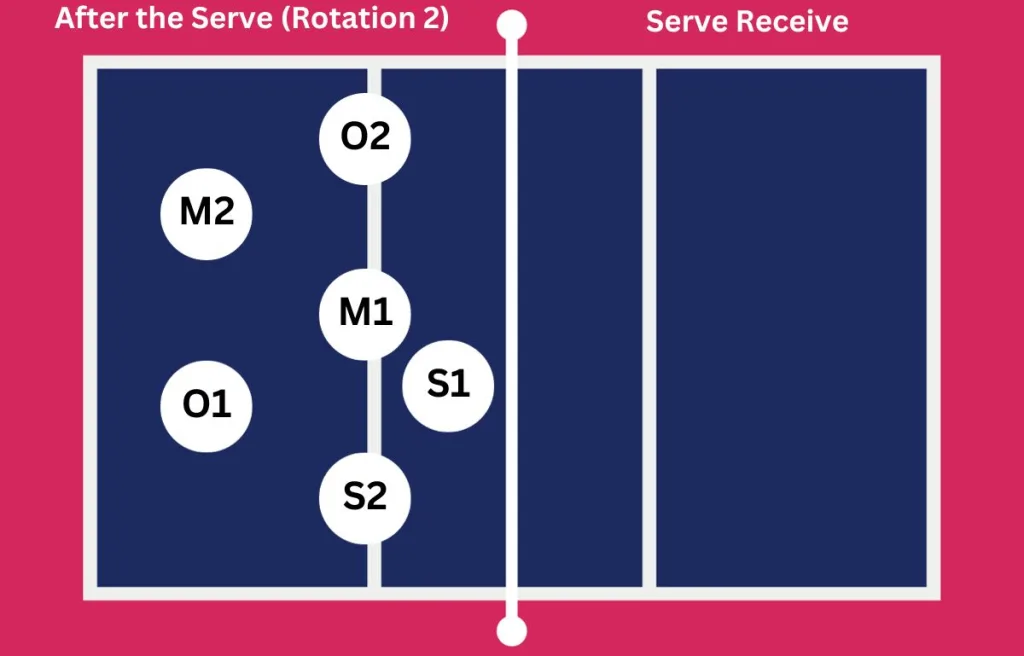
Reset and get ready!

Another clockwise turn for your team.
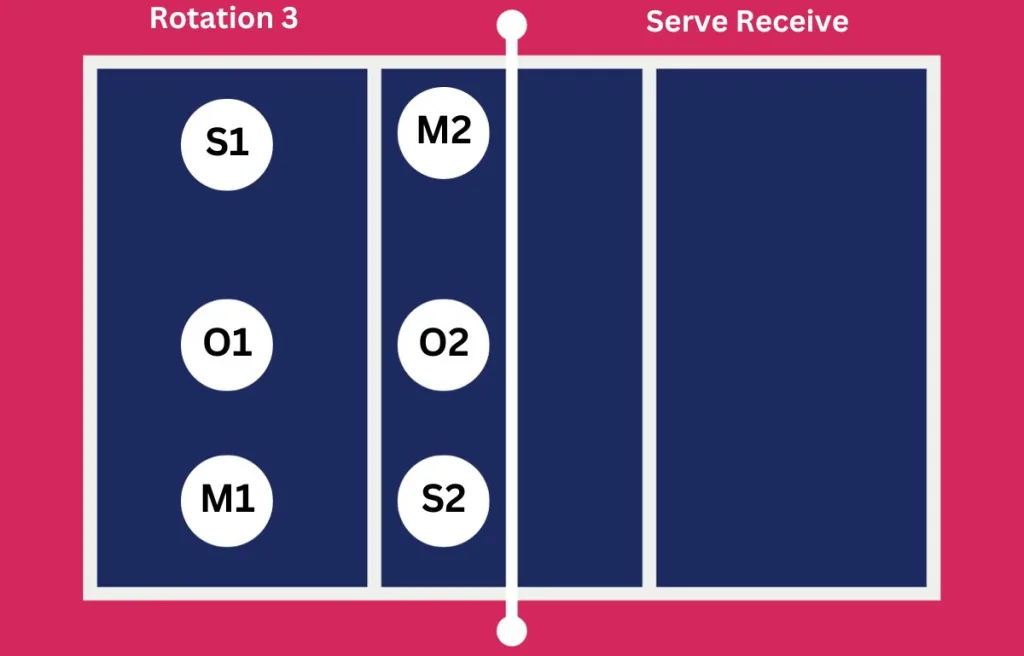
This time, the right side (S2) pulls back, allowing the outside to approach the 10-foot line.
The stack of the players will be as follows:
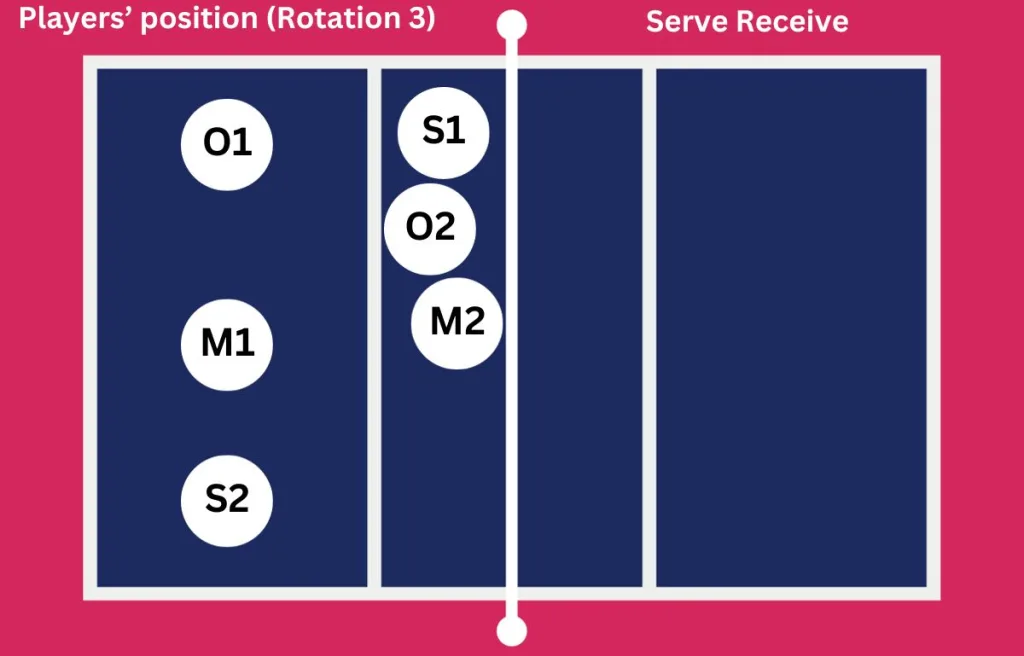
Post-serve receive, you will shift to your offensive zones.

After getting the point, it’s time to get back to the base position.
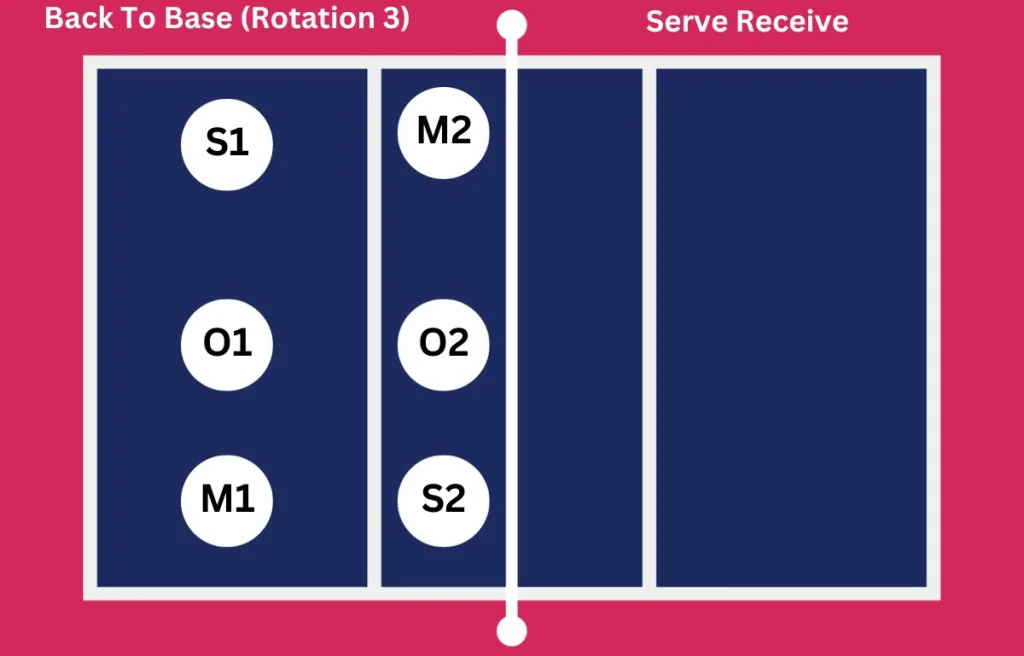
Rotation patterns in the 6-2 system are repetitive.
So, if you’ve understood the first three, you’re set for the rest!
For instance, the fourth rotation would look like:
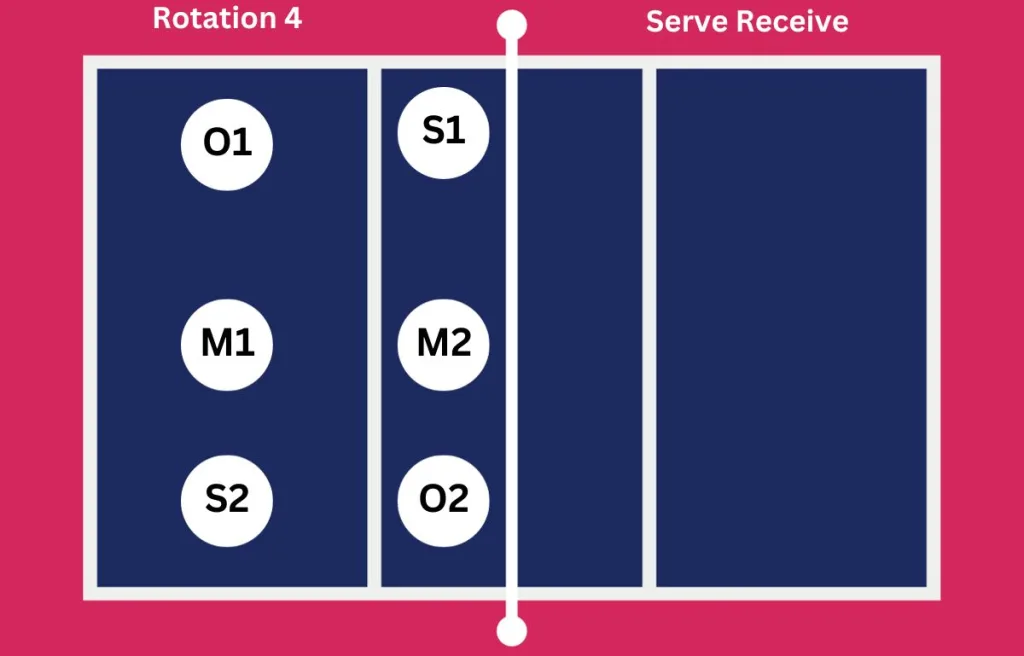
I have good news for you.
If you have understood the 6-2 serve receive rotations, grasping the concept of serve rotations would be super easy for you.
For this, I have also worked on creating diagrams to explain each rotation better.
Check out the diagram!
I’ve labeled Setter 2 as “RS” to keep things straightforward.
It’s the same as the base position in our serve receive.
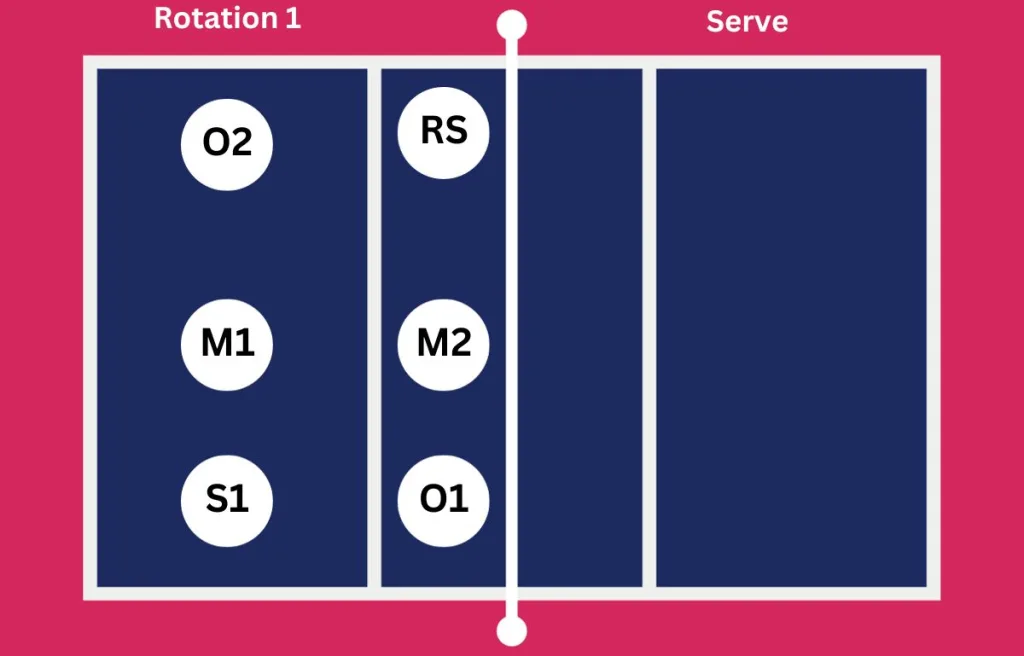
As you can see above, S1 got the ball and is preparing to serve.
Meanwhile, the squad’s all here, standing in formation:
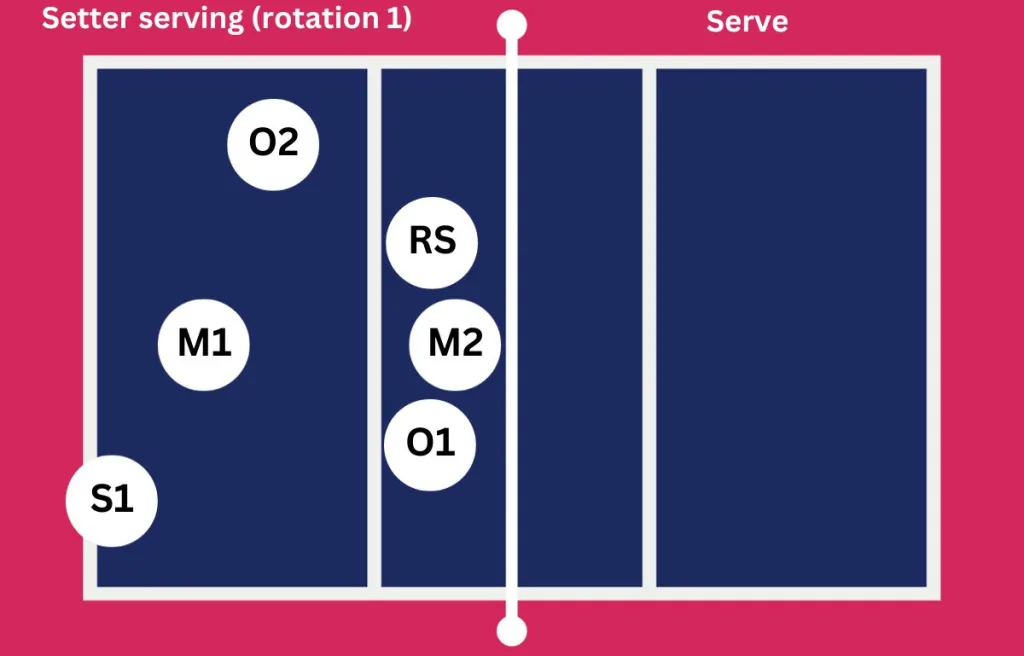
Notice how O1, RS, and M2 are like the Three Musketeers are standing side by side.
This tight-knit formation is by design.
It makes it a breeze for the Right Side (RS) and Outside (O) to switch spots post-serve.
After the serve, the players’ formation may look like this:
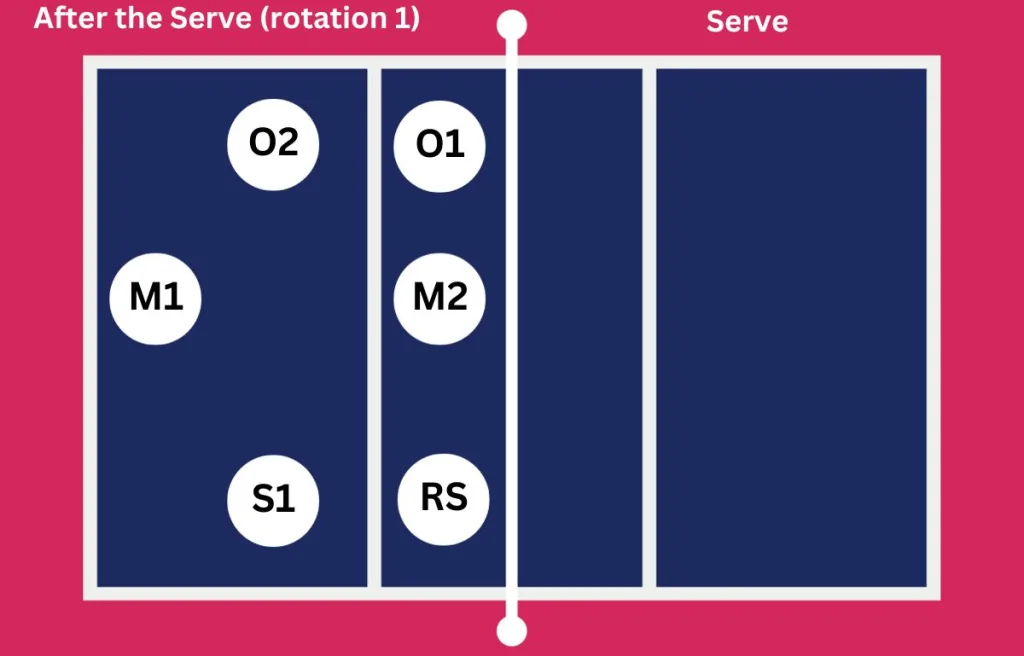
Then, like superheroes, everyone returns to their base after saving the day.
Just chilling and waiting for the next move.
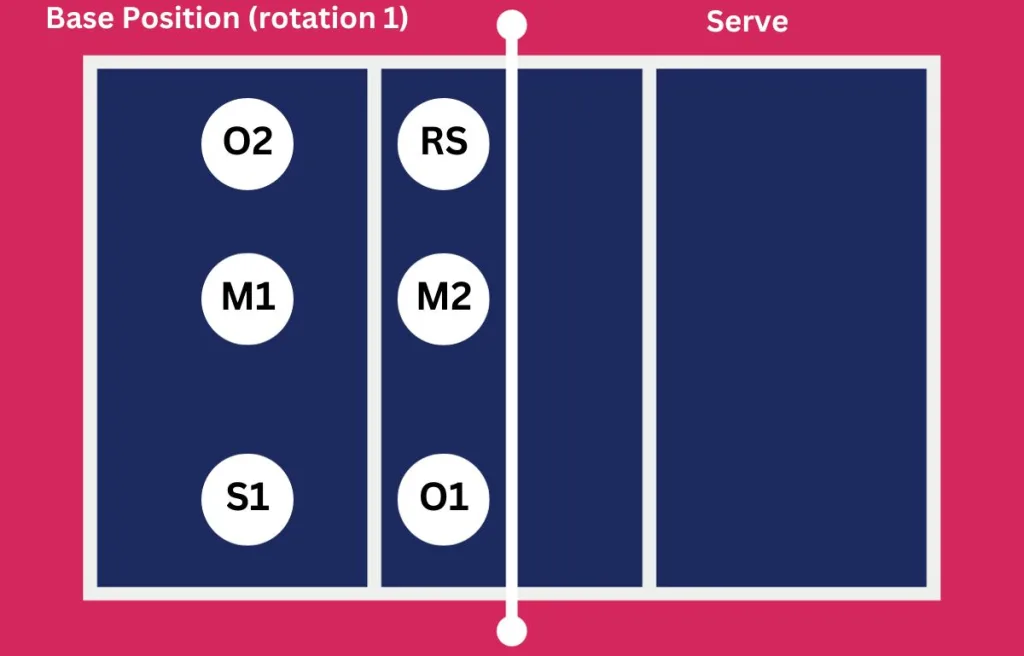
You’ve just won serving rights, Hurrah!
Keep the momentum going, and time to rotate clockwise.
Yep, just like the hands of a clock.
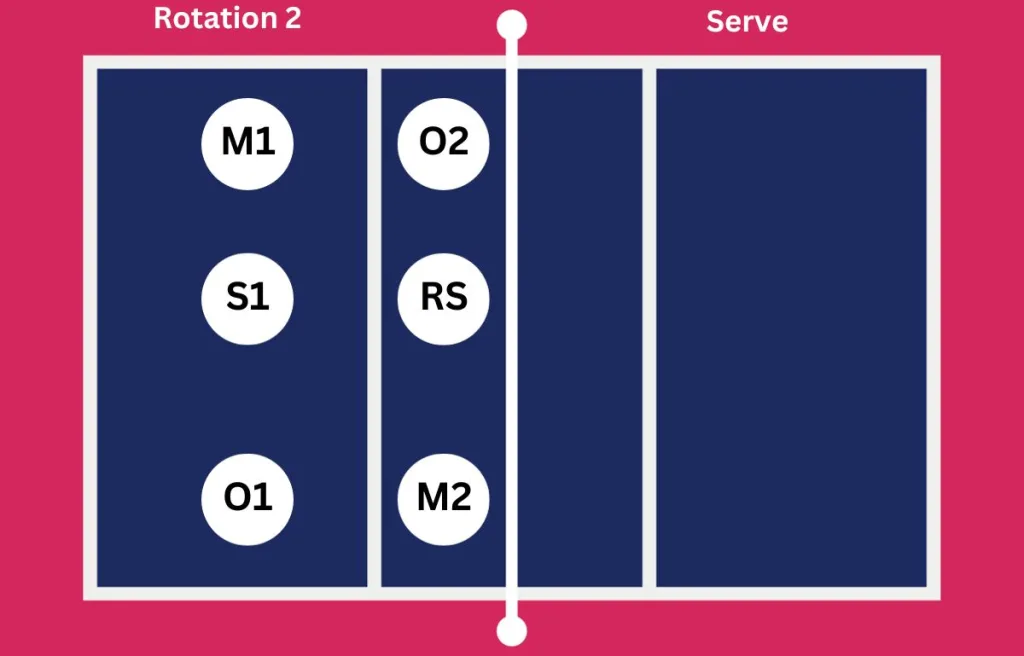
Its serving time for O1 and the formation will be as follows:
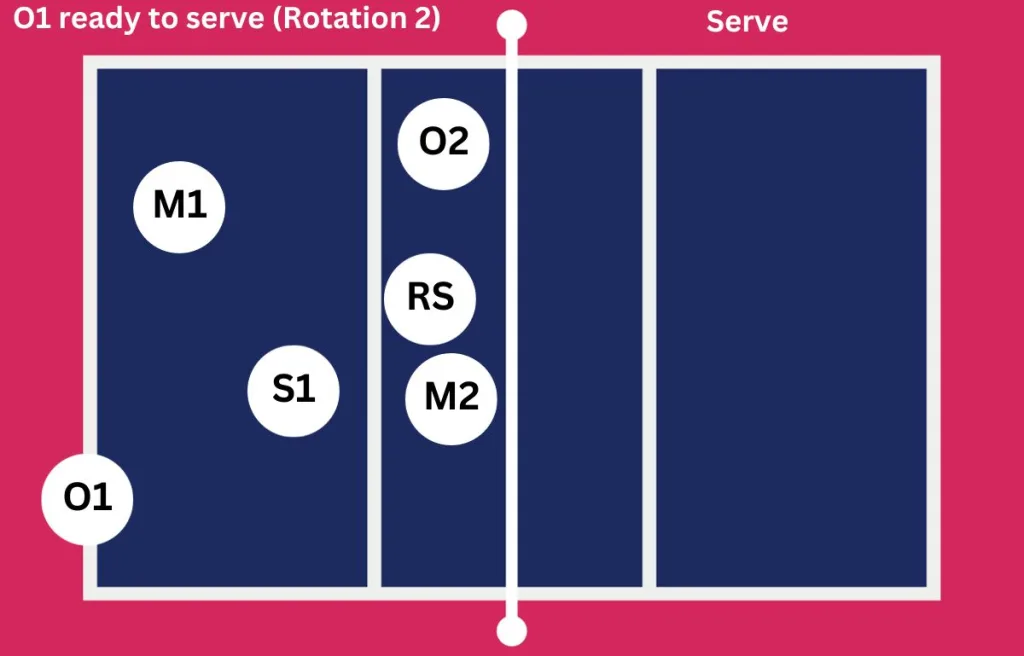
After the serve, everyone’s diving back to base defense like synchronized swimmers.
Just look at that coordination.
That’s what makes me crazy about volleyball!
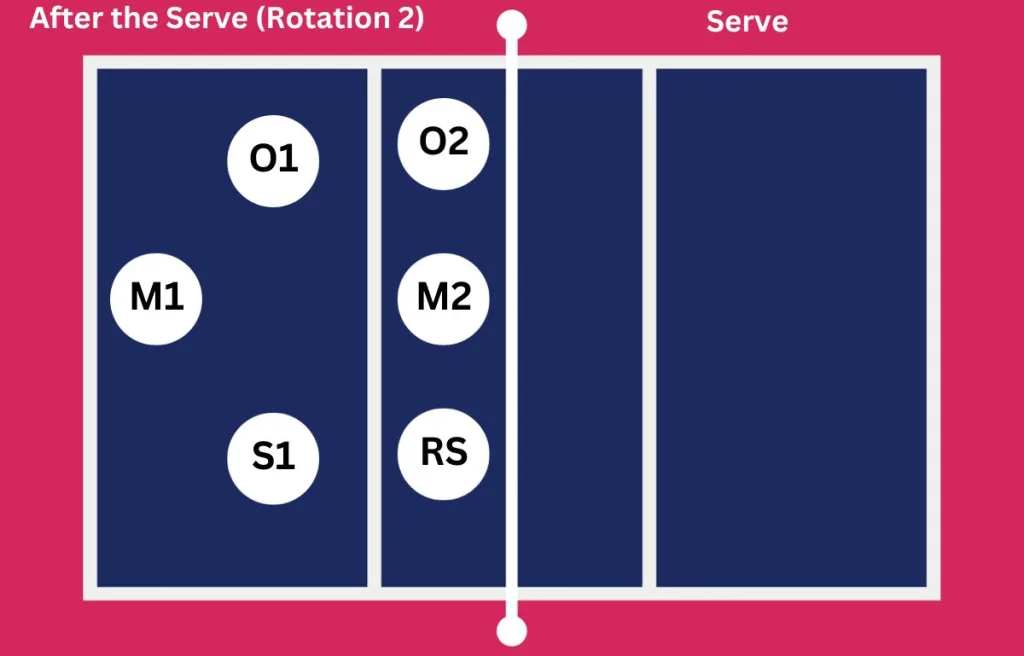
The same story repeats..
Everyone comes to the base position as of rotation 2.
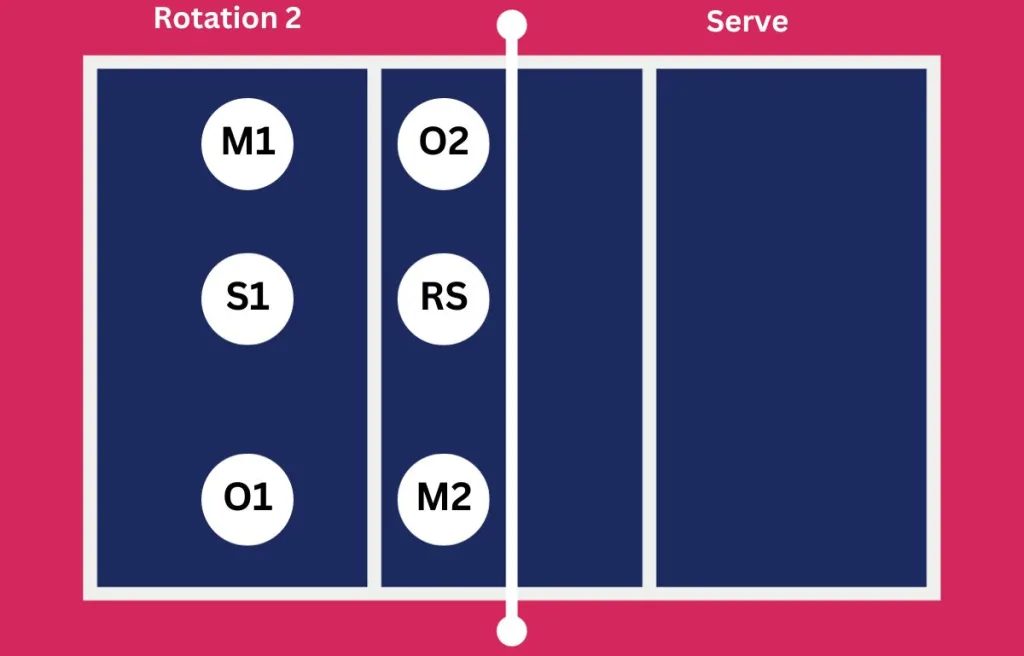
Imagine that you won again.
I mean you really won it!
Now, it’s time to rotate in the clockwise direction again.
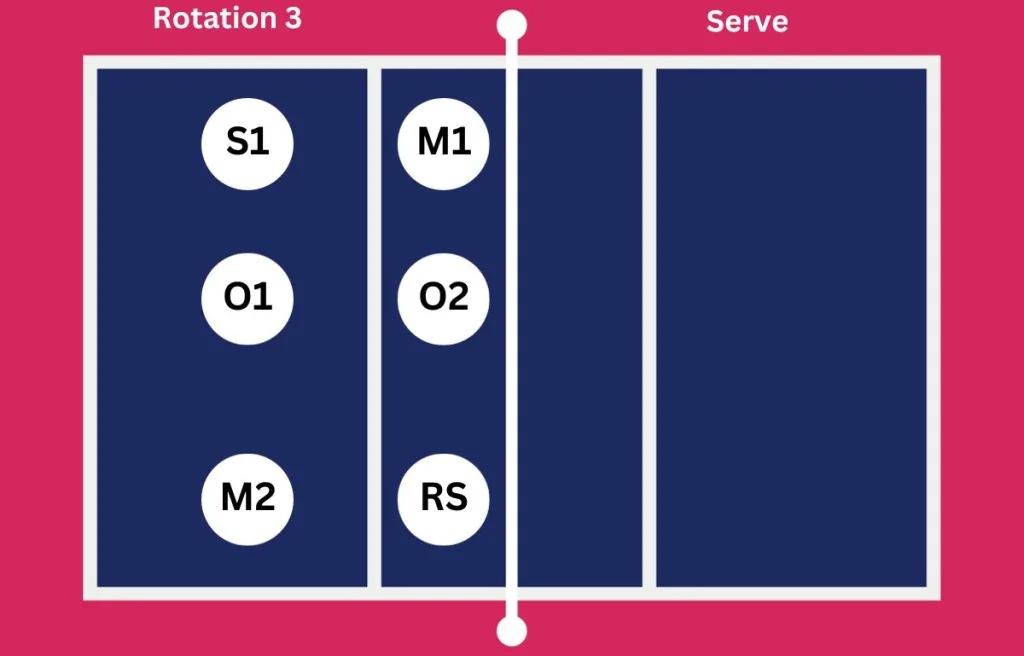
Now, M2 got the chance to serve.
Ready, set, serve!
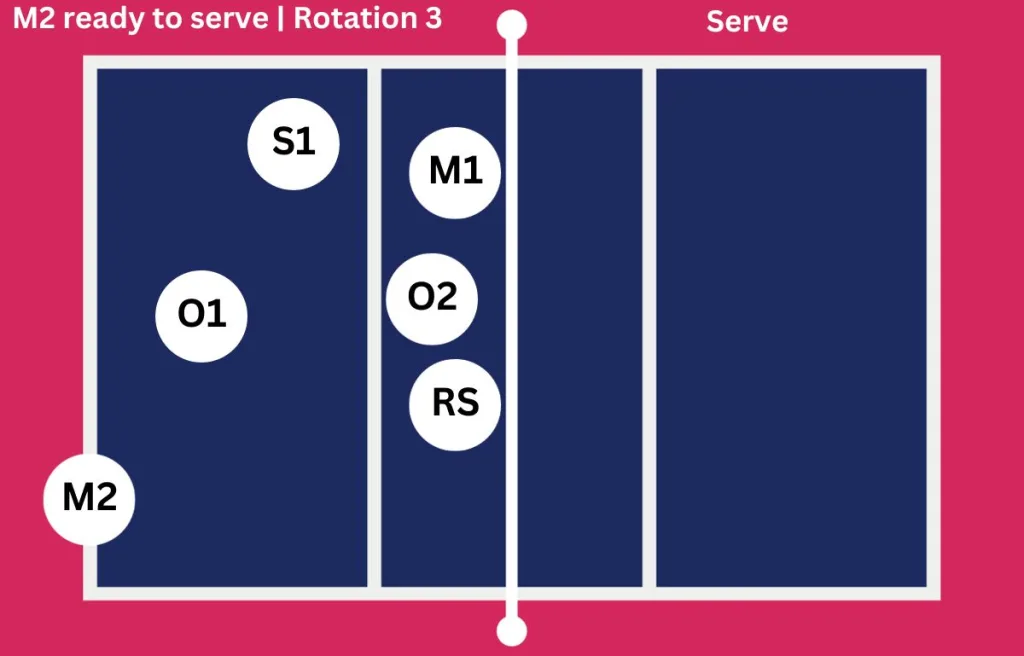
The ensemble of players?
Here’s how they line up after the serve.

If you win the set again, you’ll start the rotations from the beginning.
Just remember the first three serve-receive setups.
Get those right, and you’re good to go!
For those of you wanting a quick reference, I’ve prepared a cheat sheet of the serve receive diagrams discussed earlier in the article.
Simply click the button below to download it in PDF format.
Similarly, just click the button below if you’d like a cheat sheet for the serve diagrams.
This PDF is beneficial if you plan to print and share it with your players.
The 6-2 volleyball rotation is a unique and strategic approach many teams implement for its advantages.
It involves having 6 potential hitters and 2 setters, optimizing the number of attackers at any given point.
However, like any strategy, it comes with challenges, such as needing two skilled setters and understanding the nature of substitutions.
But with consistent practice and understanding, teams can utilize the full potential of the 6-2 rotation.
Volleyball Coach & Blogger
I am Asher James, the passionate founder and head coach of Volley Mentor, with over two decades of experience in playing and coaching volleyball. Through Volley Mentor, I strive to share my extensive knowledge and expertise, inspiring players worldwide to excel in volleyball.